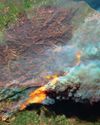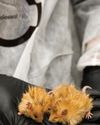Intentar ORO - Gratis
INVESTIGATING ICY MOONS
Muse Science Magazine for Kids
|March 2024
The Search for Hidden Oceans-and Extra-Terrestrial Life

On April 14, 2023, a sleek rocket took off from Europe's Spaceport in French Guiana, in northeast South America. It blasted beyond Earth's atmosphere, soaring into the darkness of space. Onboard was a brand new space probe called the Jupiter Icy Moons Explorer, or Juice for short. Juice has an exciting trip ahead. It will travel through our solar system, with its sights set on reaching the planet Jupiter by July 2031. This probe will be so far from Earth-hundreds of millions of miles away—that it needs a 2.5-meter (8.2-foot) antenna to send information to us back home. It is also equipped with large solar panels to provide power. Once near Jupiter, Juice will embark on a planned four-year mission to study the planet and its mysterious icy moons: Ganymede, Callisto, and Europa.
Galileo Galilei (1564-1642) first spotted these moons along with Io (which isn't icy) in 1610. It seemed as if they were all too far from the Sun to have life. Space probes such as Galileo (1989-2003) and Cassini (1997-2017), however, have sparked fresh interest in the possibility of alien life on water-rich worlds. Galileo hinted at the existence of hidden oceans on Europa, Ganymede, and Callisto, and Cassini caught Saturn's moon Enceladus shooting water plumes into space.

Water Could Mean Life
Why is water such a big deal? "Scientists have spent decades looking for life in space, and they start by finding places with water," says Olivier Witasse. He is the project scientist for European Space Agency's Juice mission.
Esta historia es de la edición March 2024 de Muse Science Magazine for Kids.
Suscríbete a Magzter GOLD para acceder a miles de historias premium seleccionadas y a más de 9000 revistas y periódicos.
¿Ya eres suscriptor? Iniciar sesión
MÁS HISTORIAS DE Muse Science Magazine for Kids

Muse Science Magazine for Kids
ANIMAL FIREFIGHTER TO THE RESCUE
Can animals help manage the risks of deadly wildfires?
3 mins
Muse July 2025: The Story Behind Wildfires

Muse Science Magazine for Kids
FIRE DANGER
WHY THE RISK OF WILDFIRES KEEPS GROWING
4 mins
Muse July 2025: The Story Behind Wildfires

Muse Science Magazine for Kids
The Miller NEW Normal
WHAT TODAY’S WILDFIRES TELL US ABOUT OUR FUTURE
8 mins
Muse July 2025: The Story Behind Wildfires

Muse Science Magazine for Kids
WOMEN AND FIREFIGHTING: A GOOD FIT
Jessica Gardetto is a firefighter. Her father was, too. “I grew up with my dad coming home smelling like wildfire and covered in soot,” she says.
1 min
Muse July 2025: The Story Behind Wildfires

Muse Science Magazine for Kids
What is happening on your fingertips when they get all wrinkly in a hot tub?
—Felix G., age 10, Montana
1 mins
Muse July 2025: The Story Behind Wildfires

Muse Science Magazine for Kids
WHEN the SMOKE CLEARS
THE LINGERING EFFECTS OF THE RECENT PACIFIC PALISADES AND ALTADENA EATON FIRES
6 mins
Muse July 2025: The Story Behind Wildfires

Muse Science Magazine for Kids
PICKING TEAMS
Keep it fair with a strategy that relies on geometry.
2 mins
Muse July 2025: The Story Behind Wildfires

Muse Science Magazine for Kids
SHAN CAMMACK
WILDLIFE BIOLOGIST AND FIRE SAFETY OFFICER
3 mins
Muse July 2025: The Story Behind Wildfires

Muse Science Magazine for Kids
Scientists Create Mice With Woolly Mammoth-Like Fur
RESEARCHERS AT A COMPANY IN TEXAS ARE WORKING TO CREATE A LIVING ANIMAL THAT RESEMBLES THE EXTINCT WOOLLY MAMMOTH. Recently, they produced mice with traits of the large mammal. The mice all have coats with mammoth-like fur, and some of the small mammals also have genes that help them store fat. Both features would help the animals survive in the cold Arctic, where the woolly mammoth once lived.
1 min
Muse July 2025: The Story Behind Wildfires

Muse Science Magazine for Kids
Cool Sunshade Added to the Nancy Roman Space Telescope
THE NANCY ROMAN SPACE TELESCOPE IS A NEW TELESCOPE THAT NASA IS BUILDING AND WILL LAUNCH INTO SPACE, LIKELY IN EARLY 2027.
1 min
Muse July 2025: The Story Behind Wildfires
Listen
Translate
Change font size

